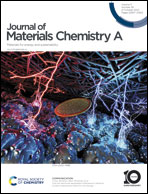Unveiling dual catalysis enhancement of a pyridinium-containing Zn(ii) coordination polymer in aerobic photooxidation of organic substrates and selective photoreduction of CO2†
Abstract
We herein report two Zn(II)–terpyridine coordination polymers for photoredox reactions. One coordination polymer bearing the pyridinium unit is able to activate molecular O2 in air for photooxidation of organic substrates without external additives. Various kinds of organic compounds including sulfides, amines, alcohols, and N-heterocycles are oxidized into corresponding products under mild conditions. Moreover, this coordination polymer is also able to activate CO2 for photoreduction of CO2 with selective CO evolution. In contrast, the other coordination polymer exhibits no catalytic reactivity in aerobic photooxidation of organic substrates and displays a lower CO yield in photoreduction of CO2. Spectroscopic studies and photoelectrochemical measurements reveal that the former coordination polymer has a longer-lived photoexcited state, more efficient separation of photogenerated electrons and holes, and more stable active sites in photocatalysis. These findings provide key insights on photocatalytic performances of coordination polymers, and pave the way to rationally design multifunctional coordination polymers for both photooxidation and photoreduction reactions.



 Please wait while we load your content...
Please wait while we load your content...